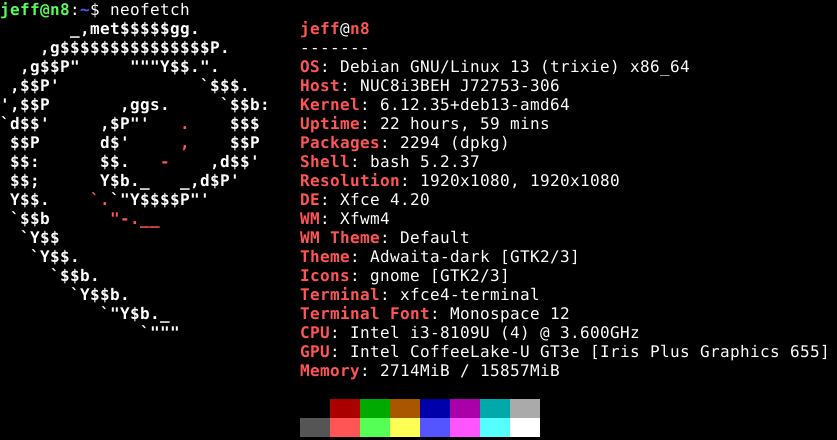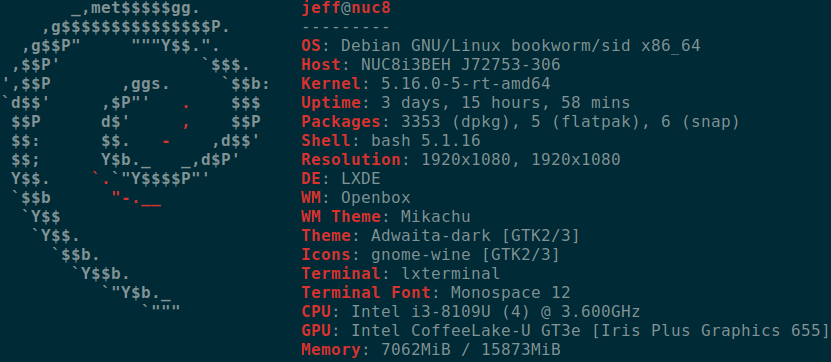Updated 03-Aug-2025
The venerable Neofetch hasn't been updated since 2020 (and was archived last year). Fastfetch is it's reasonable replacement (with a bit more info). Fastfetch is available in apt repositories and also from the git repository (latest editions). Fastfetch was last updated 18-July-2025 and gets ongoing support. The version in apt lags a bit (since April), so download from git if latest is needed.
Neofetch (obsolete)

Farfetch (current)

Old Neofetch info
Neofetch is a CLI system information tool written in BASH. Neofetch displays information about your system next to an image, your OS logo, or any ASCII file of your choice. It is an active Github repository with 230 contributors and over 5,000 edits.
Neofetch Readme
> Neofetch is a command-line system information tool written in bash 3.2+. Neofetch displays information about your operating system, software and hardware in an aesthetic and visually pleasing way. > > The overall purpose of Neofetch is to be used in screen-shots of your system. Neofetch shows the information other people want to see. There are other tools available for proper system statistic/diagnostics. > > The information by default is displayed alongside your operating system's logo. You can further configure Neofetch to instead use an image, a custom ASCII file, your wallpaper or nothing at all. > > You can further configure Neofetch to display exactly what you want it to. Through the use of command-line flags and the configuration file you can change existing information outputs or add your own custom ones. > > Neofetch supports almost 150 different operating systems. From Linux to Windows, all the way to more obscure operating systems like Minix, AIX and Haiku. If your favourite operating system is unsupported: Open up an issue and support will be added.
Neofetch Example
This Neofetch example shows the various kinds of information that are displayed when running the command neofetch:

Neofetch usage options
Neofetch is highly configurable, with a plethora of usage options.
INFO:
func_name Specify a function name (second part of info() from config) to
quickly display only that function's information.
Example: neofetch uptime --uptime_shorthand tiny
Example: neofetch uptime disk wm memory
This can be used in bars and scripts like so:
memory="$(neofetch memory)"; memory="${memory##*: }"
For multiple outputs at once (each line of info in an array):
IFS=$'\n' read -d "" -ra info < <(neofetch memory uptime wm)
info=("${info[@]##*: }")
--disable infoname Allows you to disable an info line from appearing
in the output. 'infoname' is the function name from the
'print_info()' function inside the config file.
For example: 'info "Memory" memory' would be '--disable memory'
NOTE: You can supply multiple args. eg. 'neofetch --disable cpu gpu'
--title_fqdn on/off Hide/Show Fully Qualified Domain Name in title.
--package_managers on/off Hide/Show Package Manager names . (on, tiny, off)
--os_arch on/off Hide/Show OS architecture.
--speed_type type Change the type of cpu speed to display.
Possible values: current, min, max, bios,
scaling_current, scaling_min, scaling_max
NOTE: This only supports Linux with cpufreq.
--speed_shorthand on/off Whether or not to show decimals in CPU speed.
NOTE: This flag is not supported in systems with CPU speed less than
1 GHz.
--cpu_brand on/off Enable/Disable CPU brand in output.
--cpu_cores type Whether or not to display the number of CPU cores
Possible values: logical, physical, off
NOTE: 'physical' doesn't work on BSD.
--cpu_speed on/off Hide/Show cpu speed.
--cpu_temp C/F/off Hide/Show cpu temperature.
NOTE: This only works on Linux and BSD.
NOTE: For FreeBSD and NetBSD-based systems, you need to enable
coretemp kernel module. This only supports newer Intel processors.
--distro_shorthand on/off Shorten the output of distro (on, tiny, off)
NOTE: This option won't work in Windows (Cygwin)
--kernel_shorthand on/off Shorten the output of kernel
NOTE: This option won't work in BSDs (except PacBSD and PC-BSD)
--uptime_shorthand on/off Shorten the output of uptime (on, tiny, off)
--refresh_rate on/off Whether to display the refresh rate of each monitor
Unsupported on Windows
--gpu_brand on/off Enable/Disable GPU brand in output. (AMD/NVIDIA/Intel)
--gpu_type type Which GPU to display. (all, dedicated, integrated)
NOTE: This only supports Linux.
--de_version on/off Show/Hide Desktop Environment version
--gtk_shorthand on/off Shorten output of gtk theme/icons
--gtk2 on/off Enable/Disable gtk2 theme/font/icons output
--gtk3 on/off Enable/Disable gtk3 theme/font/icons output
--shell_path on/off Enable/Disable showing $SHELL path
--shell_version on/off Enable/Disable showing $SHELL version
--disk_show value Which disks to display.
Possible values: '/', '/dev/sdXX', '/path/to/mount point'
NOTE: Multiple values can be given. (--disk_show '/' '/dev/sdc1')
--disk_subtitle type What information to append to the Disk subtitle.
Takes: name, mount, dir, none
'name' shows the disk's name (sda1, sda2, etc)
'mount' shows the disk's mount point (/, /mnt/Local Disk, etc)
'dir' shows the basename of the disks's path. (/, Local Disk, etc)
'none' shows only 'Disk' or the configured title.
--disk_percent on/off Hide/Show disk percent.
--ip_host url URL to query for public IP
--ip_timeout int Public IP timeout (in seconds).
--song_format format Print the song data in a specific format (see config file).
--song_shorthand on/off Print the Artist/Album/Title on separate lines.
--memory_percent on/off Display memory percentage.
--memory_unit kib/mib/gib Memory output unit.
--music_player player-name Manually specify a player to use.
Available values are listed in the config file
TEXT FORMATTING:
--colors x x x x x x Changes the text colors in this order:
title, @, underline, subtitle, colon, info
--underline on/off Enable/Disable the underline.
--underline_char char Character to use when underlining title
--bold on/off Enable/Disable bold text
--separator string Changes the default ':' separator to the specified string.
COLOR BLOCKS:
--color_blocks on/off Enable/Disable the color blocks
--col_offset auto/num Left-padding of color blocks
--block_width num Width of color blocks in spaces
--block_height num Height of color blocks in lines
--block_range num num Range of colors to print as blocks
BARS:
--bar_char 'elapsed char' 'total char'
Characters to use when drawing bars.
--bar_border on/off Whether or not to surround the bar with '[]'
--bar_length num Length in spaces to make the bars.
--bar_colors num num Colors to make the bar.
Set in this order: elapsed, total
--cpu_display mode Bar mode.
Possible values: bar, infobar, barinfo, off
--memory_display mode Bar mode.
Possible values: bar, infobar, barinfo, off
--battery_display mode Bar mode.
Possible values: bar, infobar, barinfo, off
--disk_display mode Bar mode.
Possible values: bar, infobar, barinfo, off
IMAGE BACKEND:
--backend backend Which image backend to use.
Possible values: 'ascii', 'caca', 'chafa', 'jp2a', 'iterm2',
'off', 'sixel', 'tycat', 'w3m', 'kitty'
--source source Which image or ascii file to use.
Possible values: 'auto', 'ascii', 'wallpaper', '/path/to/img',
'/path/to/ascii', '/path/to/dir/', 'command output' [ascii]
--ascii source Shortcut to use 'ascii' backend.
NEW: neofetch --ascii "$(fortune | cowsay -W 30)"
--caca source Shortcut to use 'caca' backend.
--chafa source Shortcut to use 'chafa' backend.
--iterm2 source Shortcut to use 'iterm2' backend.
--jp2a source Shortcut to use 'jp2a' backend.
--kitty source Shortcut to use 'kitty' backend.
--pot source Shortcut to use 'pot' backend.
--pixterm source Shortcut to use 'pixterm' backend.
--sixel source Shortcut to use 'sixel' backend.
--termpix source Shortcut to use 'termpix' backend.
--tycat source Shortcut to use 'tycat' backend.
--w3m source Shortcut to use 'w3m' backend.
--off Shortcut to use 'off' backend (Disable ascii art).
NOTE: 'source; can be any of the following: 'auto', 'ascii', 'wallpaper', '/path/to/img',
'/path/to/ascii', '/path/to/dir/'
ASCII:
--ascii_colors x x x x x x Colors to print the ascii art
--ascii_distro distro Which Distro's ascii art to print
NOTE: AIX, Alpine, AlterLinux, Anarchy, Android, Antergos, antiX,
"AOSC OS", "AOSC OS/Retro", Apricity, ArcoLinux, ArchBox,
ARCHlabs, ArchStrike, XFerience, ArchMerge, Arch, Artix, Arya,
Bedrock, Bitrig, BlackArch, BLAG, BlankOn, BlueLight, bonsai, BSD,
BunsenLabs, Calculate, Carbs, CentOS, Chakra, ChaletOS, Chapeau,
Chrom, Cleanjaro, ClearOS, Clear_Linux, Clover, Condres,
Container_Linux, CRUX, Cucumber, Debian, Deepin, DesaOS, Devuan,
DracOS, DarkOs, DragonFly, Drauger, Elementary, EndeavourOS, Endless,
EuroLinux, Exherbo, Fedora, Feren, FreeBSD, FreeMiNT, Frugalware,
Funtoo, GalliumOS, Garuda, Gentoo, Pentoo, gNewSense, GNOME, GNU,
GoboLinux, Grombyang, Guix, Haiku, Huayra, Hyperbola, janus, Kali,
KaOS, KDE_neon, Kibojoe, Kogaion, Korora, KSLinux, Kubuntu, LEDE,
LFS, Linux_Lite, LMDE, Lubuntu, Lunar, macos, Mageia, MagpieOS,
Mandriva, Manjaro, Maui, Mer, Minix, LinuxMint, MX_Linux, Namib,
Neptune, NetBSD, Netrunner, Nitrux, NixOS, Nurunner, NuTyX,
OBRevenge, OpenBSD, openEuler, OpenIndiana, openmamba, OpenMandriva,
OpenStage, OpenWrt, osmc, Oracle, OS Elbrus, PacBSD, Parabola,
Pardus, Parrot, Parsix, TrueOS, PCLinuxOS, Peppermint, popos,
Porteus, PostMarketOS, Proxmox, Puppy, PureOS, Qubes, Radix,
Raspbian, Reborn_OS, Redstar, Redcore, Redhat, Refracted_Devuan,
Regata, Rosa, sabotage, Sabayon, Sailfish, SalentOS, Scientific,
Septor, SereneLinux, SharkLinux, Siduction, Slackware, SliTaz,
SmartOS, Solus, Source_Mage, Sparky, Star, SteamOS, SunOS,
openSUSE_Leap, openSUSE_Tumbleweed, openSUSE, SwagArch, Tails,
Trisquel, Ubuntu-Budgie, Ubuntu-GNOME, Ubuntu-MATE, Ubuntu-Studio,
Ubuntu, Venom, Void, Obarun, windows10, Windows7, Xubuntu, Zorin,
and IRIX have ascii logos
NOTE: Arch, Ubuntu, Redhat, and Dragonfly have 'old' logo variants.
NOTE: Use '{distro name}_old' to use the old logos.
NOTE: Ubuntu has flavor variants.
NOTE: Change this to Lubuntu, Kubuntu, Xubuntu, Ubuntu-GNOME,
Ubuntu-Studio, Ubuntu-Mate or Ubuntu-Budgie to use the flavors.
NOTE: Arcolinux, Dragonfly, Fedora, Alpine, Arch, Ubuntu,
CRUX, Debian, Gentoo, FreeBSD, Mac, NixOS, OpenBSD, android,
Antrix, CentOS, Cleanjaro, ElementaryOS, GUIX, Hyperbola,
Manjaro, MXLinux, NetBSD, Parabola, POP_OS, PureOS,
Slackware, SunOS, LinuxLite, OpenSUSE, Raspbian,
postmarketOS, and Void have a smaller logo variant.
NOTE: Use '{distro name}_small' to use the small variants.
--ascii_bold on/off Whether or not to bold the ascii logo.
-L, --logo Hide the info text and only show the ascii logo.
IMAGE:
--loop Redraw the image constantly until Ctrl+C is used. This fixes issues
in some terminals emulators when using image mode.
--size 00px | --size 00% How to size the image.
Possible values: auto, 00px, 00%, none
--crop_mode mode Which crop mode to use
Takes the values: normal, fit, fill
--crop_offset value Change the crop offset for normal mode.
Possible values: northwest, north, northeast,
west, center, east, southwest, south, southeast
--xoffset px How close the image will be to the left edge of the
window. This only works with w3m.
--yoffset px How close the image will be to the top edge of the
window. This only works with w3m.
--bg_color color Background color to display behind transparent image.
This only works with w3m.
--gap num Gap between image and text.
NOTE: --gap can take a negative value which will move the text
closer to the left side.
--clean Delete cached files and thumbnails.
OTHER:
--config /path/to/config Specify a path to a custom config file
--config none Launch the script without a config file
--no_config Don't create the user config file.
--print_config Print the default config file to stdout.
--stdout Turn off all colors and disables any ASCII/image backend.
--help Print this text and exit
--version Show neofetch version
-v Display error messages.
-vv Display a verbose log for error reporting.
DEVELOPER:
--gen-man Generate a manpage for Neofetch in your PWD. (Requires GNU help2man)